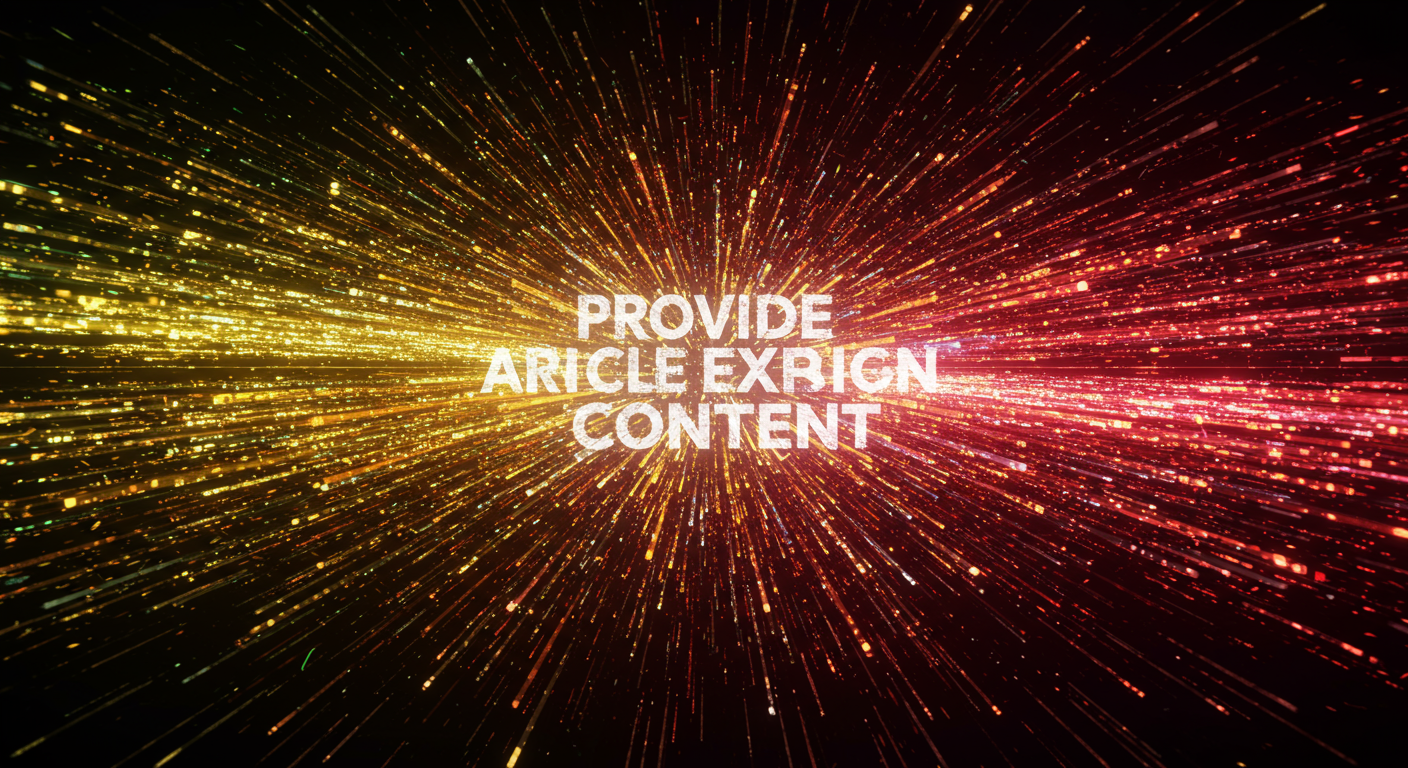Unlocking Content’s Hidden Gold: A Beginner’s Guide to AI-Powered Keyword Extraction
John: In the ever-shifting landscape of digital marketing, staying ahead of the curve is paramount. For years, Search Engine Optimization (SEO) has been a game of meticulous research and human intuition. But today, we’re witnessing a seismic shift, powered by the same artificial intelligence that’s transforming every other industry. We’re talking about using AI to dissect content and pull out the most valuable keywords, a process that’s as powerful as it is accessible.
Lila: So, it’s like having a super-smart robot assistant that reads an article and tells you exactly what terms you need to use to get noticed by Google? That sounds almost too good to be true. Where does a beginner even start with something that sounds so complex?
John: That’s the perfect way to put it, Lila. And it’s not too good to be true; it’s just the new reality. Think of it less as a complex, intimidating technology and more as a new, powerful tool in your toolkit. It automates the most time-consuming part of SEO: understanding the language that connects you with your audience. The starting point is simpler than you’d think. It begins with understanding the core concept and what you need to feed the machine.

The “Supplies”: What Do You Need to Get Started?
John: To make this work, you don’t need a supercomputer or a degree in data science. The “supply” chain is quite simple. You need three things: a source text, which could be a competitor’s top-ranking article or your own draft; an AI model, like the ones powering ChatGPT, Claude, or specialized SEO tools; and a clear objective, defined by a well-crafted prompt.
Lila: Okay, that makes sense. So, if I’m writing a blog post about, say, “sustainable gardening,” I could grab the top three articles from Google on that topic. But what about the AI model? I hear about tools like ChatGPT, but also dedicated SEO platforms like SurferSEO or MarketMuse. Is a free tool like ChatGPT’s basic version enough, or do you really need to invest in a paid service to get good results?
John: An excellent and practical question. The free tiers of major Large Language Models (LLMs) are surprisingly capable for basic keyword extraction. You can paste a competitor’s text into ChatGPT and ask it to identify the main keywords, related concepts, and LSI keywords (Latent Semantic Indexing, which are basically terms conceptually related to the main topic). However, paid tools and premium AI versions, like GPT-4, offer significant advantages. They have larger context windows (meaning they can analyze longer articles), better reasoning capabilities, and are often integrated with real-time search data. Specialized SEO tools go a step further by layering search volume, keyword difficulty, and other crucial metrics on top of the AI’s analysis. For a beginner, starting free is a great way to learn the ropes. For a business, investing in a specialized tool often provides a much higher return on investment through superior data.
The Technical Mechanism: How Does the AI “Think”?
John: This is where the magic happens. The AI isn’t “reading” in the human sense. It’s using a field of computer science called Natural Language Processing (NLP) to mathematically deconstruct the text. The process generally involves a few key steps. First, the AI breaks the text down into smaller pieces—a process called tokenization. Then, it performs tasks like Part-of-Speech (POS) Tagging to identify nouns, verbs, and adjectives, and Named Entity Recognition (NER) to find specific entities like people, products, or locations.
Lila: Whoa, that’s a lot of jargon. Can you give me an analogy? If I were explaining this to a friend who’s a complete tech novice, how would I describe it?
John: Of course. Imagine the AI is a master chef given a complex sauce. First, the chef doesn’t just taste it; they break it down. They use a technique (tokenization) to separate every single ingredient. Then, they identify the type of each ingredient (POS Tagging): this is a spice, this is a vegetable, this is a fat. After that, they identify the specific, important ingredients (NER): “This isn’t just any spice; it’s saffron. This isn’t just a vegetable; it’s a San Marzano tomato.” Finally, and most importantly, they use their experience to understand how these ingredients work together to create the overall flavor profile. This is semantic analysis. The AI analyzes the relationships between words to understand the article’s true meaning and context, not just the frequency of words.
Lila: The chef analogy is perfect! So it’s not just counting how many times a word appears, which is what I always thought keyword research was about. It’s about understanding the *recipe* of the article. So when I see people talking about things like “TF-IDF,” is that part of this process?
John: Precisely. You’ve hit on a key point. Old SEO methods were about keyword density, which is like a chef thinking the best sauce is the one with the most salt. It’s a terrible approach. Modern AI uses more sophisticated concepts. TF-IDF (Term Frequency-Inverse Document Frequency) is a classic example. It’s a statistical measure that evaluates how relevant a word is to a document in a collection of documents. In simple terms, it helps the AI find words that are important to *this specific article* but not common across *all articles*. An LLM goes even further by using something called vector embeddings. It represents words and sentences as complex numerical arrays, or vectors. In this mathematical space, words with similar meanings are located close to each other. This is how an AI can understand that “sustainable gardening,” “eco-friendly horticulture,” and “green thumb practices” are all part of the same conceptual cluster, even if the exact words are different.

The Players and The Field: Teams and Communities
John: When we talk about the “teams” behind this revolution, we’re looking at the tech giants. OpenAI (the creators of ChatGPT), Google (with its Gemini models and integration into search), and Anthropic (the company behind Claude) are the primary drivers of the underlying AI technology. Then you have the secondary layer: the “teams” building specialized applications on top of these models—companies like SurferSEO, NeuronWriter, and Clearscope, who focus exclusively on the SEO and content creation niche.
Lila: And where do people talk about this stuff? If I want to learn more and see real-world examples, I’m guessing there are online communities for this. It feels like something that’s evolving so fast, you’d need to be plugged into the daily conversation.
John: You’re absolutely right. The conversation is happening in real-time. For a beginner, I’d recommend a few places. X (formerly Twitter) has a vibrant community of SEO professionals who share prompts, results, and insights daily. Follow recognized experts in the field. There are also dedicated subreddits like r/SEO and r/bigseo where practitioners discuss AI’s impact. Finally, many of the specialized tools have their own Facebook groups or Discord communities, which are goldmines for practical, hands-on advice from fellow users.
Practical Magic: Use-Cases and The Future Outlook
John: The practical applications are vast. Beyond just extracting keywords from a single article, you can use AI for:
- Content Gap Analysis: You can give an AI your article and a competitor’s article and ask, “What topics and keywords does my competitor cover that I’ve missed?”
- On-Page SEO Optimization: After writing a draft, you can ask the AI to act as an SEO expert and suggest improvements for your H1, meta description, and subheadings based on a target keyword.
- Generating Structured Data: You can ask the AI to create FAQ schema markup (a type of code that helps Google understand questions and answers on your page) based on your article’s content, which can help you win rich snippets in search results.
- Semantic Keyword Clustering: You can provide a long list of potential keywords and ask the AI to group them into semantically related clusters, helping you plan your content pillars and topic clusters more effectively.
Lila: I love the content gap idea! It feels like having a secret weapon for competitor research. Thinking about the future, could we see AI not just extracting keywords, but basically building an entire SEO strategy for you? Like, you tell it your business, and it just spits out a full six-month content plan?
John: We’re moving in that direction, but with a human-in-the-loop caveat. The future isn’t just about SEO (Search Engine Optimization) anymore; it’s about GEO (Generative Engine Optimization). This means optimizing your content not just to be found by search engines, but to be used directly by AI models in their generative answers, like Google’s AI Overviews. The AI will be able to generate content plans, but a skilled strategist will still be needed to validate the AI’s suggestions, align them with business goals, and inject the creativity and brand voice that AI can’t replicate. The future is a partnership, not a replacement.
Choosing Your Tool: A Competitor Comparison
John: When choosing a tool, it’s about matching its strengths to your needs. Let’s break down a few key players.
- ChatGPT (GPT-4): This is the all-purpose Swiss Army knife. It’s incredibly versatile for brainstorming, prompt-based extraction, and rephrasing. Its strength is its conversational creativity. Its weakness is that it lacks real-time search data and specific SEO metrics out of the box.
- Anthropic’s Claude: Claude’s main advantage is its enormous context window. You can paste entire books or massive research papers into it for analysis, making it fantastic for deep dives into very long-form content. It’s often praised for its nuanced and detailed text analysis.
- Specialized SEO Tools (e.g., NeuronWriter, SurferSEO): These are the laser-focused specialists. They integrate AI keyword extraction with a wealth of other data: SERP analysis, search volume, keyword difficulty, and a content editor that gives you real-time optimization scores. Their strength is that they are purpose-built for the task. The trade-off is the cost and a narrower focus.
Lila: So if I’m a solo blogger on a tight budget, I should probably master prompting with the free or basic versions of ChatGPT or Claude. But if I’m a marketing agency managing multiple clients, investing in a specialized tool would be a no-brainer because of the efficiency and data it provides?
John: Exactly. The right tool depends on your scale, budget, and specific goals. There’s no single “best” tool, only the best tool for a particular job. The key is to understand what each one offers and how it aligns with your workflow.

Proceed with Caution: Risks and Considerations
John: As with any powerful tool, there are risks. The most common pitfall is over-optimization. An AI might give you a list of 50 keywords, and a novice might try to stuff all of them into an article, making it unreadable for humans. Google’s algorithms are smart enough to penalize this. Another risk is AI hallucination, where the model confidently makes up facts or keywords that aren’t relevant. You must always use the AI’s output as a starting point, not a final command.
Lila: I think the biggest fear for many people in my position—just starting out in content and marketing—is that this technology will make our jobs obsolete. If an AI can do the research and even write the content, what’s left for us to do?
John: It’s a valid concern, but I see it as a role evolution, not elimination. AI is excellent at handling the data-driven, repetitive parts of the job. This frees up human creators to focus on what AI can’t do: strategy, creativity, empathy, and building a genuine community. Your job shifts from being a manual researcher to being a strategic editor, a creative director, and a brand storyteller. You’re the pilot, guiding the powerful AI engine. The most valuable professionals will be those who learn to leverage AI, not those who compete against it.
Expert Opinions and Analysis
John: The consensus among leading SEO experts is clear: AI is not a trend; it’s the new foundation. Aleyda Solis, a renowned international SEO consultant, often speaks about using AI to automate technical SEO audits and scale content analysis in ways that were previously impossible. Rand Fishkin, a co-founder of Moz and SparkToro, provides a more cautious but pragmatic view, emphasizing that AI tools are most powerful when they augment, not replace, human audience research and intuition. The core message from the experts is to embrace the technology, but to do so critically and strategically, always prioritizing genuine value for the end-user.
Lila: So the pros are essentially saying, “Use the tool, but don’t let the tool use you.” It still comes down to understanding your audience, which is something a human will always do better.
John: You’ve distilled it perfectly. That’s the key takeaway.
Latest News and The Future Roadmap
John: The field is moving at lightning speed. The biggest recent development is Google’s wide rollout of AI Overviews. This is where Google’s AI provides a direct summary answer at the top of the search results, often reducing clicks to individual websites. This is a monumental shift. The “roadmap” for SEO now involves creating content that is so high-quality, well-structured, and authoritative that Google’s AI chooses to cite it in these overviews. This means a greater emphasis on factual accuracy, clear headings (H1, H2, H3), and using structured data.
Lila: So to stay ahead, we need to think not just “How do I rank #1?” but “How do I become the source for the AI’s answer?” How can someone possibly keep up with all these changes?
John: It’s a challenge, but manageable. Following key industry publications like Search Engine Land or the Moz Blog is essential. Subscribing to newsletters from AI and SEO experts provides curated updates. And most importantly, constant experimentation. Spend an hour a week testing new prompts, trying new tools, and analyzing the results. In this new era, continuous learning isn’t just an advantage; it’s a necessity.
Frequently Asked Questions (FAQ)
Can AI truly understand search intent?
John: To a large degree, yes. By analyzing the language, structure, and topics of top-ranking pages for a given query, an AI can infer the search intent (whether it’s informational, commercial, navigational, or transactional). It can identify if users are looking for a “how-to” guide, a product review, or a direct purchase page. However, it can miss subtle cultural nuances, so human verification is still crucial.
What is the best AI prompt for extracting keywords?
Lila: I’ve been experimenting, and I’ve found that being super specific works best. Is there a “magic” prompt?
John: There’s no single magic prompt, but a great starting point is a role-playing prompt. For example: “Act as an expert SEO analyst and content strategist. I am providing you with the text from a top-ranking article for the target keyword ‘[your keyword]’. Please analyze this text and provide me with: 1. A list of the top 10 primary and secondary keywords. 2. A list of 15-20 related LSI keywords and concepts. 3. A list of questions the article answers, formatted for a potential FAQ section. 4. Identify the core user intent behind this article.”
How is this different from a traditional keyword research tool like Ahrefs or SEMrush?
John: Traditional tools work from the outside-in. They crawl the web and build massive databases of keywords, telling you what people are searching for based on search volume and difficulty. AI keyword extraction works from the inside-out. It analyzes specific, successful pieces of content to tell you *why* they are successful and what language they use. The two approaches are complementary. The best strategy uses both: find high-volume keywords with a tool like Ahrefs, then analyze the top-ranking content for those keywords using AI to understand the required context and depth.
Will AI-generated content be penalized by Google?
Lila: That’s a big fear. Is it okay to use AI to help write, or will Google slap you for it?
John: Google’s official stance, updated in 2023, is that they reward high-quality content, regardless of how it is produced. They are against using AI *to generate low-quality, spammy content at scale*. If you use AI as a tool to research, outline, and assist in creating helpful, original, and people-first content, you are not violating their guidelines. The focus is on the quality of the final product, not the tools used to make it.
How much does it cost to use AI for SEO?
John: The cost can range from free to hundreds of dollars per month. You can start for free using the base versions of ChatGPT, Claude, or Google’s Gemini. A subscription to a premium model like GPT-4 or Claude Pro typically costs around $20 per month. Specialized, all-in-one AI SEO platforms can range from $50 to over $500 per month, depending on the features and usage limits. The key is to start free, demonstrate the value, and then scale your investment as you see a return.
Related Links
John: For those looking to dive deeper, we recommend exploring the official blogs of OpenAI, Google AI, and Anthropic, as well as trusted SEO resources like Search Engine Journal and the Moz Blog.
Lila: This has been incredibly enlightening, John. It feels much less like an intimidating robot takeover and more like a powerful new partnership. It’s about working smarter, not harder, and focusing our human energy on what truly matters: creativity and connection.
John: That’s the perfect summary, Lila. The future of content belongs to those who can master this partnership. It’s a new frontier, and the journey is just beginning.
Disclaimer: This article is for informational and educational purposes only. It does not constitute financial or investment advice. The world of AI and SEO is constantly changing, so always conduct your own research (DYOR) and test tools and strategies before implementing them on a large scale.
